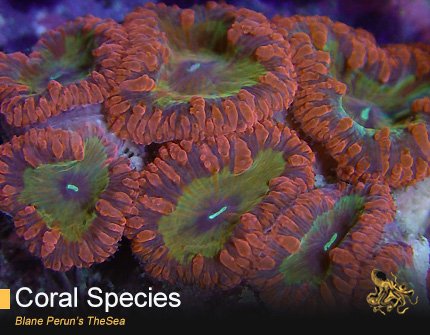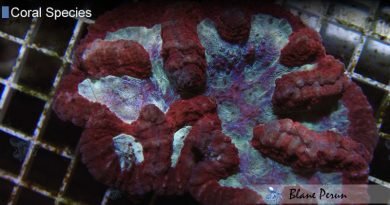Blastomussa
The blastomussa is a hard coral species of the Micromussa genus that populates the waters of the Indo-Pacific region, and is also known as a Blasto Coral, Pineapple Coral or Branched Cup Coral. Most can be found on deeper reef slopes where the position provides an excellent shield from rough wave conditions and other environmental disturbances.
Sometimes confused with the Candy Cane coral, it can be distinguished by a more compact and rounded appearance. It can also be mistaken for Mushroom Anemones because the fleshy polyps will usually cover the entire skeleton when they are wide open. Blastomussa is a rare coral, and only contains two distinct species- the Merleti and Wellsi.
Blastomussa are colonial creatures and when fully formed, resemble brain corals when polyps are completely open. The centers of blastomussa are vivid neon which seems to radiate and glow when exposed to light. Species of blastomussa are usually dark red with shades of brown and green colors mixed in its bodies. The two types of blasto have very different size polyps and therefore easy to identify from one another. The B. Wellsi have polyps that are large and fleshy, and range from 1-5cm in size, while those of B. Merleti are less than one cm. The composition of B. Merleti is made of pipe-like polyps, which elongate the skeleton that connects to the base and ultimately other polyps in the colony. Reef hobbyists are able to easily propagate this type of blastomussa because of the lengthy polyps which break off easily into single or clustered polyps, allowing for new colonies to form in alternate locations.
What blastomussa doesn’t share with other types of hard corals, it makes up for in its photosynthetic nature. While it does secure food from other sources, the majority of its nutritional content is made from exclusively the minute algae it hosts within its body. When blastomussa do hunt for prey, it uses its feeding tentacles to expand and trap organisms that are brought by in the ocean currents. When these tentacles are extended to full capacity, the coral mimics the appearance of a sea anemone.
There are many organisms that live in coexistence with the blastomussa. Organisms find the corals attractive because the skeletal structure makes an obscure hiding place where they can be protected from predators. Neighboring sea creatures that prefer the blastomussa in which to settle include sponges mollusks, various sessile invertebrates and even other corals.
The blastomussa corals are hard to obtain, mainly because of their natural location within the reef, and rarity. By dwelling at significant depths and hiding on the side of lower reef slopes, blastomussa are difficult to harvest, and will therefore sell for high prices to hobbyists and reef enthusiasts. Individual polyps can sell at prices of $70 or more!
The Fascinating World of Blastomussa Corals: An Underwater Marvel
Blastomussa corals, scientifically known as Blastomussa spp., are among the most captivating and vibrant species found in the marine world. Known for their unique polyp structure and striking coloration, these corals have become increasingly popular in the aquarium hobby. This article delves into the intricate details of Blastomussa corals, offering insights that cater both to the general public’s curiosity and the more seasoned aquarium enthusiasts’ desire for depth.
Understanding Blastomussa Habitat and Distribution
Geographical Range of Blastomussa
Blastomussa corals thrive in specific habitats, predominantly found in the warm, shallow waters of the Indo-Pacific region. They are particularly abundant in areas like the Great Barrier Reef and the Red Sea. These corals favor environments where water conditions, such as temperature and salinity, are stable, preferring depths ranging from 8 to 30 meters. Their habitat selection is crucial for their survival, as it provides the optimal conditions for photosynthesis and feeding.
Adaptation to Marine Environments
Blastomussa corals exhibit remarkable adaptations to their marine surroundings. They possess a symbiotic relationship with zooxanthellae, microscopic algae that reside within their tissues. This symbiosis allows the corals to obtain energy through photosynthesis, which is vital for their growth and coloration. Additionally, their robust skeletal structure provides resilience against environmental stressors like changes in water quality and temperature.
Blastomussa Coral Morphology and Identification
Distinctive Physical Characteristics
The physical appearance of Blastomussa corals is distinctive and varied. These corals exhibit a range of colors, from deep reds to vibrant greens, and have a distinctively fleshy appearance. Their polyps are large and swollen, often resembling a cluster of grapes. Each polyp is surrounded by a hard, calcareous skeleton, which forms the structural base of the coral colony.
Species Variations within Blastomussa
There are several species within the Blastomussa genus, including Blastomussa wellsi and Blastomussa merleti. While they share common features, each species has unique characteristics. For instance, B. wellsi typically has larger polyps than B. merleti. These differences are not just aesthetic but also indicative of their varying environmental preferences and reproductive strategies.
Care and Maintenance of Blastomussa in Aquariums
Optimal Aquarium Conditions for Blastomussa
For aquarists keen on maintaining Blastomussa corals, understanding and replicating their natural habitat is key. These corals require stable water conditions, with specific ranges in temperature, pH, and salinity. Adequate lighting and moderate water flow are also crucial to mimic the natural conditions of their habitat and to promote healthy growth and coloration in an aquarium setting.
Challenges in Blastomussa Aquaculture
While Blastomussa corals are popular in the aquarium trade, they present certain challenges in aquaculture. These corals are sensitive to rapid changes in water conditions and can be susceptible to common coral diseases. Maintaining optimal water quality and regular monitoring for signs of stress or disease are essential for the successful cultivation of these corals in captivity.
Blastomussa Coral Reproduction and Growth
Sexual and Asexual Reproduction in Blastomussa
Blastomussa corals reproduce both sexually and asexually. Sexual reproduction occurs through the release of gametes into the water column, leading to external fertilization. Asexual reproduction, on the other hand, happens through a process called budding, where new polyps develop from the parent colony. Both methods play a significant role in the growth and propagation of these corals in the wild and in aquariums.
Growth Patterns and Rate
The growth rate of Blastomussa corals varies depending on environmental conditions and species. Generally, these corals have a moderate growth rate, forming new polyps and expanding their colonies over time. Understanding their growth patterns is crucial for aquarists, as it helps in predicting space requirements and managing coral health in an aquarium setting.
Conclusion
Blastomussa corals, with their unique beauty and intriguing biology, offer a window into the complex and vibrant world of coral reefs. Whether for the casual observer or the dedicated aquarist, understanding these corals enriches our appreciation of marine life and underscores the importance of their conservation.
FAQs on Blastomussa Corals
- What are the ideal water conditions for keeping Blastomussa corals in an aquarium? The ideal conditions include stable water temperatures between 75-82°F, a pH level of 8.1-8.4, and specific gravity (salinity) around 1.025. Consistent water quality, moderate lighting, and water flow are also crucial for their wellbeing.
- How do Blastomussa corals reproduce? They reproduce both sexually and asexually. Sexual reproduction involves the release of gametes for external fertilization, while asexual reproduction happens through budding, where new polyps grow directly from the parent colony.
- Can Blastomussa corals be easily grown in home aquariums? Yes, they can be grown in home aquariums, but they require careful attention to water quality, lighting, and feeding. They are sensitive to changes in their environment, so maintaining stable conditions is key.
- What are the main differences between Blastomussa wellsi and Blastomussa merleti? The primary difference lies in their polyp size and coloration. B. wellsi typically has larger polyps and a wider range of colors compared to B. merleti. They also have slightly different environmental preferences.
- How can you tell if a Blastomussa coral is healthy in an aquarium? A healthy Blastomussa coral will have vibrant colors, fully extended polyps, and a firm attachment to the substrate. Signs of stress include receding or pale polyps, sluggish response to feeding, and any unusual spots or discoloration.




